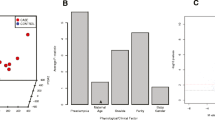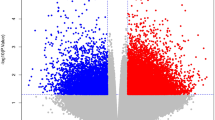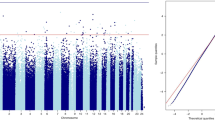Abstract
Purpose
Smoking during pregnancy has long been known as an important risk factor for sudden infant death syndrome (SIDS). However, the precise relationship between the smoking behavior of the mother and SIDS still remains unclear. In this study, the influence of prenatal smoking exposure on the childrens’ DNA methylation state of a CpG island located upstream of the promoter of the growth factor independent 1 (GFI1) gene was analyzed.
Methods
Blood samples of well-defined SIDS cases with non-smoking mothers (n = 11), SIDS cases with smoking mothers during pregnancy (n = 11), and non-SIDS cases (n = 6) were obtained from a previous study and methylation states were determined by bisulfite sequencing.
Results
Significant hypomethylation was observed in this CpG island in SIDS cases with cigarette smoke exposure compared to non-exposed cases. The strongest effect in this CpG island was observed for 49 CpG sites located within a transcription factor binding site. Coding for a transcriptional repressor, GFI1 plays an important role in various developmental processes. Alterations in the GFI1 expression might be linked to various conditions that are known to be associated with SIDS, such as dysregulated hematopoiesis and excessive inflammatory response.
Conclusion
Data obtained in this study show that analysis of methylation states in cases of sudden infant death syndrome might provide a further important piece of knowledge toward understanding SIDS, and should be investigated in further studies.




Similar content being viewed by others
References
Krous HF, Beckwith JB, Byard RW, Rognum TO, Bajanowski T, Corey T, et al. Sudden infant death syndrome and unclassified sudden infant deaths: a definitional and diagnostic approach. Pediatrics. 2004;114:234–8.
Bergman AB. Synthesis. In: Bergman AB, Beckwith JB, Ray CG, editors. Sudden infant death syndrome. Seattle: University of Washington Press; 1970. p. 210–1.
Filiano JJ, Kinney HC. A perspective on neuropathologic findings in victims of the sudden infant death syndrome: the triple-risk model. Biol Neonatol. 1994;65:194–7.
Malloy MH, Hoffman HJ. Prematurity, sudden infant death syndrome, and age of death. Pediatrics. 1995;96:464–71.
Blair PS, Platt MW, Smith IJ, Fleming PJ. Sudden infant death syndrome and sleeping position in pre-term and low birth weight infants: an opportunity for targeted intervention. Arch Dis Child. 2006;91:101–6.
Mitchell EA, Stewart AW. Gender and the sudden infant death syndrome. New Zealand Cot Death Study Group. Acta Paediatr. 1997;86:854–6.
Fleming PJ, Gilbert R, Azaz Y, Berry PJ, Rudd PT, Stewart A, et al. Interaction between bedding and sleeping position in the sudden infant death syndrome: a population based case-control. BMJ. 1990;301:85–9.
Schlaud M, Kleemann WJ, Poets CF, Sens B. Smoking during pregnancy and poor antenatal care: two major preventable risk factors for sudden infant death syndrome. Int J Epidemiol. 1996;25:959–65.
Scragg RK, Mitchell EA. Side sleeping position and bed sharing in the sudden infant death syndrome. Ann Med. 1998;30:345–9.
Vennemann MM, Findeisen M, Butterfass-Bahloul T, Jorch G, Brinkmann B, Köpcke W, et al. Modifiable risk factors for SIDS in Germany: results of GeSID. Acta Paediatr. 2005;94:655–60.
Darnall RA, Harris MB, Gill WH, Hoffman JM, Brown JW, Niblock MM. Inhibition of serotonergic neurons in the nucleus paragigantocellularis lateralis fragments sleep and decreases rapid eye movement sleep in the piglet: implications for sudden infant death syndrome. J Neurosci. 2005;25:8322–32.
Tryba AK, Pena F, Ramirez JM. Gasping activity in vitro: a rhythm dependent on 5-HT2A receptors. J Neurosci. 2006;26:2623–34.
Läer K, Vennemann M, Rothamel T, Klintschar M. Association between polymorphisms in the P2RY1 and SSTR2 genes and sudden infant death syndrome. Int J Legal Med. 2013;127:1087–91.
Läer K, Dork T, Vennemann M, Rothamel T, Klintschar M. Polymorphisms in genes of respiratory control and sudden infant death syndrome. Int J Legal Med. 2015;129:977–84.
Van Norstrand DW, Tester DJ, Ackerman MJ. Overrepresentation of the proarrhythmic, sudden death predisposing sodium channel polymorphism S1103Y in a population- based cohort of African-American sudden infant death syndrome. Heart Rhythm. 2008;5:712–5.
Ferrante L, Opdal SH, Vege A, Rognum TO. TNF-alpha promoter polymorphisms in sudden infant death. Hum Immunol. 2008;69:368–73.
Opdal SH, Vege A, Saugstad OD, Rognum TO. Is partial deletion of the complement C4 genes associated with sudden infant death? Eur J Pediatr. 1994;153:287–90.
Schneider PM, Wendler C, Riepert T, Braun L, Schacker U, Horn M, et al. Possible association of sudden infant death with partial complement C4 deficiency revealed by post-mortem DNA typing of HLA class II and III genes. Eur J Pediatr. 1989;149:170–4.
Summers AM, Summers CW, Drucker DB, Hajeer AH, Barson A, Hutchinson IV. Association of IL-10 genotype with sudden infant death syndrome. Hum Immunol. 2000;61:1270–3.
Opdal SH, Rognum TO. The sudden infant death syndrome gene: does it exist? Pediatrics. 2004;114:e506–12.
Law JA, Jacobsen SE. Establishing, maintaining and modifying DNA methylation patterns in plants and animals. Nat Rev Genet. 2010;11:204–20.
Reik W, Dean W, Walter J. Epigenetic reprogramming in mammalian development. Science. 2001;293:1089–93.
Reik W, Walter J. Genomic imprinting: parental influence on the genome. Nat Rev Genet. 2001;2:21–32.
Chow J, Heard E. X inactivation and the complexities of silencing a sex chromosome. Curr Opin Cell Biol. 2009;21:359–66.
Wolf SF, Migeon BR. Studies of X chromosome DNA methylation in normal human cells. Nature. 1982;295:667–71.
Chen RZ, Pettersson U, Beard C, Jackson-Grusby L, Jaenisch R. DNA hypomethylation leads to elevated mutation rates. Nature. 1998;395:89–93.
Singal R, Ginder GD. DNA methylation. Blood. 1999;93:4059–70.
Tate PH, Bird AP. Effects of DNA methylation on DNA-binding proteins and gene expression. Curr Opin Genet Dev. 1993;3:226–31.
Terry MB, Delgado-Cruzata L, Vin-Raviv N, Wu HC, Santella RM. DNA methylation in white blood cells: association with risk factors in epidemiologic studies. Epigenetics. 2011;6:828–37.
Suter M, Aagaard K. What changes in DNA methylation take place in individuals exposed to maternal smoking in utero? Epigenomics. 2012;4:115–8.
Breitling LP, Yang R, Korn B, Burwinkel B, Brenner H. Tobacco-smoking-related differential DNA methylation: 27 K discovery and replication. Am J Hum Genet. 2011;88:450–7.
Joubert BR, Håberg SE, Nilsen RM, Wang X, Vollset SE, Murphy SK, et al. 450 K epigenome-wide scan identifies differential DNA methylation in newborns related to maternal smoking during pregnancy. Environ Health Perspect. 2012;120:1425–31.
Zweidler-Mckay PA, Grimes HL, Flubacher MM, Tsichlis PN. Gfi-1 encodes a nuclear zinc finger protein that binds DNA and functions as a transcriptional repressor. Mol Cell Biol. 1996;16:4024–34.
Duan Z, Zarebski A, Montoya-Durango D, Grimes HL, Horwitz M. Gfi1 coordinates epigenetic repression of p21Cip/WAF1 by recruitment of histone lysine methyltransferase G9a and histone deacetylase 1. Mol Cell Biol. 2005;25:10338–51.
Khandanpour C, Kosan C, Gaudreau MC, Duhrsen U, Hebert J, Zeng H, et al. Growth factor independence 1 protects hematopoietic stem cells against apoptosis but also prevents the development of a myeloproliferative-like disease. Stem Cells. 2011;29:376–85.
Jafar-Nejad H, Bellen HJ. Gfi/Pag-3/senseless zinc finger proteins: a unifying theme? Mol Cell Biol. 2004;24:8803–12.
Möröy T, Khandanpour C. Growth factor independence 1 (Gfi1) as a regulator of lymphocyte development and activation. Semin Immunol. 2011;23:368–78.
Findeisen M, Vennemann M, Brinkmann B, Ortmann C, Röse I, Köpcke W, et al. German study on sudden infant death (GeSID): design, epidemiological and pathological profile. Int J Legal Med. 2004;118:163–9.
Breton CV, Byun HM, Wenten M, Pan F, Yang A, Gilliland FD. Prenatal tobacco smoke exposure affects global and gene-specific DNA methylation. Am J Respir Crit Care Med. 2009;180:462–7.
Ivorra C, Fraga MF, Bayon GF, Fernandez AF, Garcia-Vicent C, Chaves F, et al. DNA methylation patterns in newborns exposed to tobacco in utero. J Transl Med. 2015;13:25.
Markunas CA, Xu Z, Harlid S, Wade PA, Lie RT, Taylor JA, et al. Identification of DNA methylation changes in newborns related to maternal smoking during pregnancy. Environ Health Perspect. 2014;122:1147–53.
Nguyen LP, Bradfield CA. The search for endogenous activators of the aryl hydrocarbon receptor. Chem Res Toxicol. 2008;21:102–16.
Benetatos L, Vartholomatos G, Hatzimichael E. MEG3 imprinted gene contribution in tumorigenesis. Int J Cancer. 2011;129:773–9.
Teslovich TM, Musunuru K, Smith AV, Edmondson AW, Stylianou IM, Koseki M, et al. Biological, clinical and population relevance of 95 loci for blood lipids. Nature. 2010;466:707–13.
Marucci A, Cozzolino F, Dimatteo C, Monti M, Pucci P, Trischitta V, et al. Role of GALNT2 in the modulation of ENPP1 expression, and insulin signaling and action: GALNT2: a novel modulator of insulin signaling. Biochim Biophys Acta. 2013;1833:1388–95.
Marucci A, di Mauro L, Menzaghi C, Prudente S, Mangiacotti D, Fini G, et al. GALNT2 expression is reduced in patients with type 2 diabetes: possible role of hyperglycemia. PLoS ONE. 2013;8:e70159.
Joubert BR, Haberg SE, Bell DA, Nilsen RM, Vollset SE, Midttun O, et al. Cancer Epidemiol Biomarkers Prev. 2014;23:1007–17.
Phelan JD, Shroyer NF, Cook T, Gebelein B, Grimes HL. Gfi1—cells & circuits: unraveling transcriptional networks of development and disease. Curr Opin Hematol. 2010;17:300–7.
van der Meer LT, Jansen JH, van der Reijden BA. Gfi1 and Gfi1b: key regulators of hematopoiesis. Leukemia. 2010;24:1834–43.
Person RE, Li FQ, Duan Z, Benson KF, Wechsler J, Papadaki HA, et al. Mutations in proto-oncogene GFI1 cause human neutropenia and target ELA2. Nat Genet. 2003;34:308–12.
Huang M, Hu Z, Chang W, Ou D, Zhou J, Zhang Y. The growth factor independence-1 (Gfi1) is overexpressed in chronic myelogenous leukemia. Acta Haematol. 2010;123:1–5.
Duan Z, Horwitz M. Targets of the transcriptional repressor oncoprotein Gfi-1. Proc Natl Acad Sci USA. 2003;100:5932–7.
Phillipson EA, Sullivan CE. Arousal: the forgotten response to respiratory stimuli. Am Rev Respir Dis. 1978;118:807–9.
McCulloch K, Brouillette RT, Guzzetta AJ, Hunt CE. Arousal responses in near- miss sudden infant death syndrome and in normal infants. J Pediatr. 1982;101:911–7.
Acknowledgments
We would like to thank all forensic pathologists at the Institute of Legal medicine for thorough post-mortem examination, Athina Vidaki for helpful discussions on bisulfite sequencing and involved parents for consenting to molecular analyses.
Author information
Authors and Affiliations
Consortia
Corresponding author
Electronic supplementary material
Below is the link to the electronic supplementary material.
12024_2016_9812_MOESM1_ESM.pdf
Primer sequences designed for bisulfite sequencing of a 2600 bp region upstream of the GFI1 promoter. Differentially methylated positions are given as Y (C or T) and R (G or A) (PDF 41 kb)
12024_2016_9812_MOESM2_ESM.pdf
Mean relative methylation (MRM) values with standard deviation (SD) for 148 successfully analyzed CpG sites and all SIDS cases. MRM and SD for CpG sites of the transcription factor binding site (CpG 58-112) for non-SIDS cases. Original data on all samples and all CpG sites are available on request (PDF 96 kb)
12024_2016_9812_MOESM3_ESM.pdf
Bisulfite converted sequence of the analyzed area upstream of the GFI1 promoter region. PCR primers were designed for 8 individual reactions to cover a total of 2600 bp containing 170 CpG positions (arrows). The area of the transcription factor binding site is highlighted in red. The following 10 CpG positions were not included in the analysis due to poor sequencing quality or incomplete bisulfite conversion: 80, 135, 136, 137, 138, 139, 140, 141, 169, 170. All CpG sites located within primer binding sites were also excluded from analyses (PDF 66 kb)
12024_2016_9812_MOESM4_ESM.pdf
Supplementary Material—Fig. S2 Extreme example of differential methylation between a SIDS case not exposed (A) and exposed (B) to cigarette smoke. Asterisks indicate CpG positions 10, 11, and 13 in GFI1 fragment 2 in reverse direction. In the sequence example B a slight background with elevated peaks is visible. This does not affect the calculation of the relative methylation state because relevant positons are not affected (PDF 113 kb)
Rights and permissions
About this article
Cite this article
Schwender, K., Holtkötter, H., Johann, K.S. et al. Sudden infant death syndrome: exposure to cigarette smoke leads to hypomethylation upstream of the growth factor independent 1 (GFI1) gene promoter. Forensic Sci Med Pathol 12, 399–406 (2016). https://doi.org/10.1007/s12024-016-9812-y
Accepted:
Published:
Issue Date:
DOI: https://doi.org/10.1007/s12024-016-9812-y




